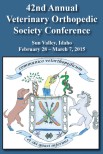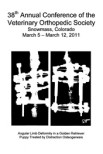Dominique J. Griffon
DMV, MS, PhD, DECVS, DACVS
Associate Dean for Research, College of Veterinary Medicine, Western University of Health, Pomona (USA)
Graduation
Ecole Nationale Veterinaire Alfort, 1989
Employment immediately after graduation
1988-1990 Associate Veterinarian - Polyclinique Vétérinaire des Drs Lecomte, Lenoel, Brunet Chatenay Malabry and Chevilly Larue, France.
1991-1992 Teaching Assistant, Small Animal Surgery - University of Minnesota Saint-Paul, Minnesota, U.S.A.
1992-1995 Resident, Small Animal Surgery - Kansas State University
Manhattan, Kansas, U.S.A.
Following appointments up to your current position
2002-2011 Director, Laboratory for Orthopedic Research on Biomaterials
Affiliate, Department of Bioengineering University of Illinois Urbana-Champaign, U.S.A.
2005-2011 Associate Professor, Small Animal Surgery - University of Illinois
Affiliate, Beckman Institute for Technology, University of Illinois Urbana-Champaign, U.S.A.
2005-2009-Section and Service Head, Small Animal Surgery - University of Illinois, Urbana-Champaign, U.S.A.
Current position
2011-present Associate Dean for Research, Professor - College of Veterinary Medicine, Western University of Health, Pomona, U.S.A.
At what age did you know that you wanted to become a veterinarian?
As far as I can remember, I have always wanted to be a veterinarian. I may have been pre-destined to this career: I was born in the Limousin, a region located in the center of France, famous for the Limousin cattle breed. Although I am proud to be “Limousine”, this is where the similarity with cows stops… As a little girl, I may have been inspired by a natural inclination and compassion toward animals, my ability to approach stray cats as well as the TV series “Daktari”. OK, the series aired in France a few years after it did in the US but it still gives out my age… I formally declared my interest when I was 6 year-old, during a family reunion. My decision was met with mixed enthusiasm by my family. My grand-parents ran a small farm in the Limousin, and did not find the profession very “lady-like”. My parents were concerned about the academic skills and workload required to pursue this training in France. Fortunately, I have been blessed with strong will; neither challenges nor doubts will make me stray once my course is set. After I passed my Baccalaureate, several fields of studies were available to me including admission in the most prestigious preparatory school for commercial and business studies in France. My parents let me choose, and I chose veterinary medicine.
When did you decide to specialize in Orthopaedics, and who were your mentors?
I decided to specialize in surgery after spending a couple of years in general small animal practice near Paris. At this point, I felt comfortable with my knowledge and skills in preventive medicine, but orthopedics felt very threatening. In search for a change of activity and adventure, I investigated options for further training in surgery and was accepted for a MS in Clinical Sciences at the University of Minnesota. My research advisor was Dr Larry Wallace, who invested significant time and enthusiasm to my training in orthopedics, research, and teaching. However, Dr Dennis Caywood was equally inspirational as he facilitated my integration into clinics, contributed to my surgical training and served as a role model balancing all aspects of life as a surgeon. My interest in orthopedics was sparked by the nature of my research and grew with my understanding and appreciation for biomechanics and objective outcomes. Later on, I was very fortunate to work with Dr Ann Johnson, whose incredible clinical experience, problem solving skills and visionary leadership inspired me as a junior faculty.
What do you think the future holds for veterinary orthopaedics?
I believe that orthopedics will continue to progress toward minimally invasive interventions and disease prevention. I expect technology and procedures to evolve to improve minimally invasive fracture fixation, bone healing stimulation, as well as management and prevention of common joint diseases such as cranial cruciate ligament deficiency, elbow dysplasia and patellar luxation. Research efforts will remain focused toward prevention, early detection and treatment of orthopedic infections. I do hope that the evolution of orthopedics will be led by scientific evidence and interdisciplinary collaboration.















